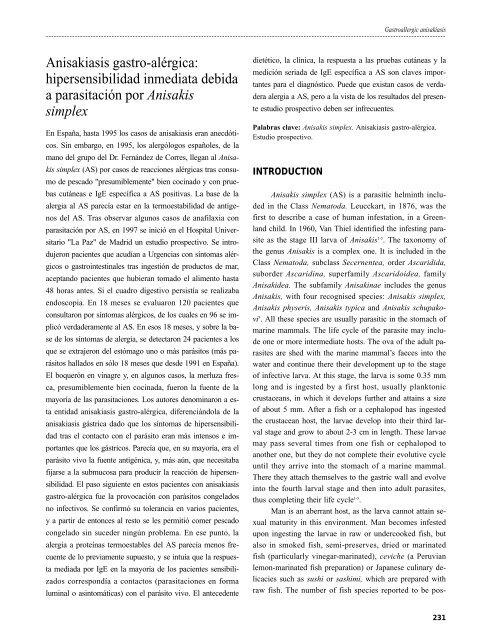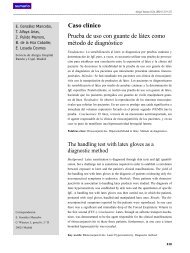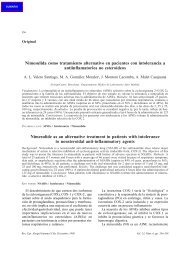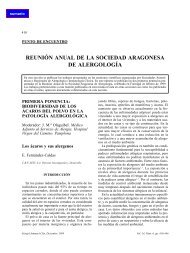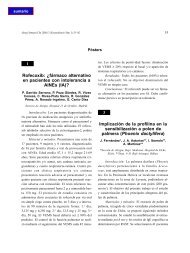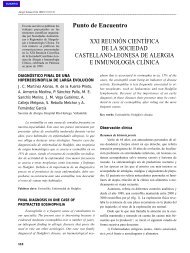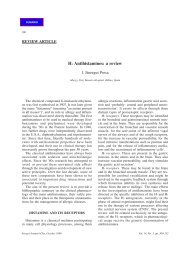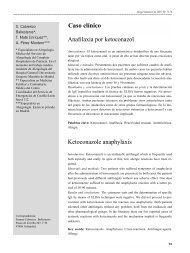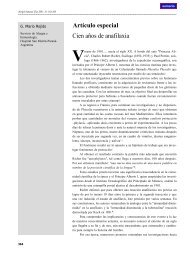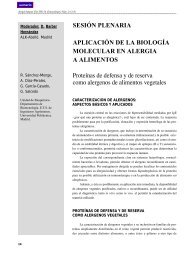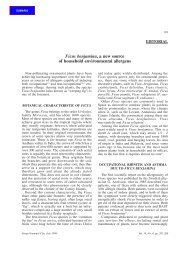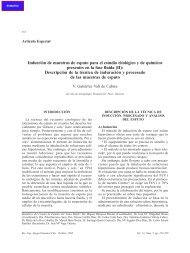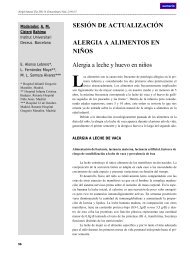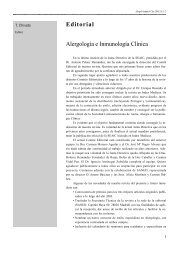Gastroallergic anisakiasis: immediate ... - Revista seaic
Gastroallergic anisakiasis: immediate ... - Revista seaic
Gastroallergic anisakiasis: immediate ... - Revista seaic
You also want an ePaper? Increase the reach of your titles
YUMPU automatically turns print PDFs into web optimized ePapers that Google loves.
<strong>Gastroallergic</strong> <strong>anisakiasis</strong><br />
Anisakiasis gastro-alérgica:<br />
hipersensibilidad inmediata debida<br />
a parasitación por Anisakis<br />
simplex<br />
En España, hasta 1995 los casos de <strong>anisakiasis</strong> eran anecdóticos.<br />
Sin embargo, en 1995, los alergólogos españoles, de la<br />
mano del grupo del Dr. Fernández de Corres, llegan al Anisakis<br />
simplex (AS) por casos de reacciones alérgicas tras consumo<br />
de pescado "presumiblemente" bien cocinado y con pruebas<br />
cutáneas e IgE específica a AS positivas. La base de la<br />
alergia al AS parecía estar en la termoestabilidad de antígenos<br />
del AS. Tras observar algunos casos de anafilaxia con<br />
parasitación por AS, en 1997 se inició en el Hospital Universitario<br />
"La Paz" de Madrid un estudio prospectivo. Se introdujeron<br />
pacientes que acudían a Urgencias con síntomas alérgicos<br />
o gastrointestinales tras ingestión de productos de mar,<br />
aceptando pacientes que hubieran tomado el alimento hasta<br />
48 horas antes. Si el cuadro digestivo persistía se realizaba<br />
endoscopia. En 18 meses se evaluaron 120 pacientes que<br />
consultaron por síntomas alérgicos, de los cuales en 96 se implicó<br />
verdaderamente al AS. En esos 18 meses, y sobre la base<br />
de los síntomas de alergia, se detectaron 24 pacientes a los<br />
que se extrajeron del estómago uno o más parásitos (más parásitos<br />
hallados en sólo 18 meses que desde 1991 en España).<br />
El boquerón en vinagre y, en algunos casos, la merluza fresca,<br />
presumiblemente bien cocinada, fueron la fuente de la<br />
mayoría de las parasitaciones. Los autores denominaron a esta<br />
entidad <strong>anisakiasis</strong> gastro-alérgica, diferenciándola de la<br />
<strong>anisakiasis</strong> gástrica dado que los síntomas de hipersensibilidad<br />
tras el contacto con el parásito eran más intensos e importantes<br />
que los gástricos. Parecía que, en su mayoría, era el<br />
parásito vivo la fuente antigénica, y, más aún, que necesitaba<br />
fijarse a la submucosa para producir la reacción de hipersensibilidad.<br />
El paso siguiente en estos pacientes con <strong>anisakiasis</strong><br />
gastro-alérgica fue la provocación con parásitos congelados<br />
no infectivos. Se confirmó su tolerancia en varios pacientes,<br />
y a partir de entonces al resto se les permitió comer pescado<br />
congelado sin suceder ningún problema. En ese punto, la<br />
alergia a proteínas termoestables del AS parecía menos frecuente<br />
de lo previamente supuesto, y se intuía que la respuesta<br />
mediada por IgE en la mayoría de los pacientes sensibilizados<br />
correspondía a contactos (parasitaciones en forma<br />
luminal o asintomáticas) con el parásito vivo. El antecedente<br />
dietético, la clínica, la respuesta a las pruebas cutáneas y la<br />
medición seriada de IgE específica a AS son claves importantes<br />
para el diagnóstico. Puede que existan casos de verdadera<br />
alergia a AS, pero a la vista de los resultados del presente<br />
estudio prospectivo deben ser infrecuentes.<br />
Palabras clave: Anisakis simplex. Anisakiasis gastro-alérgica.<br />
Estudio prospectivo.<br />
INTRODUCTION<br />
Anisakis simplex (AS) is a parasitic helminth included<br />
in the Class Nematoda. Leucckart, in 1876, was the<br />
first to describe a case of human infestation, in a Greenland<br />
child. In 1960, Van Thiel identified the infesting parasite<br />
as the stage III larva of Anisakis 1-5 . The taxonomy of<br />
the genus Anisakis is a complex one. It is included in the<br />
Class Nematoda, subclass Secernentea, order Ascaridida,<br />
suborder Ascaridina, superfamily Ascaridoidea, family<br />
Anisakidea. The subfamily Anisakinae includes the genus<br />
Anisakis, with four recognised species: Anisakis simplex,<br />
Anisakis physeris, Anisakis typica and Anisakis schupakovi<br />
5 . All these species are usually parasitic in the stomach of<br />
marine mammals. The life cycle of the parasite may include<br />
one or more intermediate hosts. The ova of the adult parasites<br />
are shed with the marine mammal’s faeces into the<br />
water and continue there their development up to the stage<br />
of infective larva. At this stage, the larva is some 0.35 mm<br />
long and is ingested by a first host, usually planktonic<br />
crustaceans, in which it develops further and attains a size<br />
of about 5 mm. After a fish or a cephalopod has ingested<br />
the crustacean host, the larvae develop into their third larval<br />
stage and grow to about 2-3 cm in length. These larvae<br />
may pass several times from one fish or cephalopod to<br />
another one, but they do not complete their evolutive cycle<br />
until they arrive into the stomach of a marine mammal.<br />
There they attach themselves to the gastric wall and evolve<br />
into the fourth larval stage and then into adult parasites,<br />
thus completing their life cycle 1-5 .<br />
Man is an aberrant host, as the larva cannot attain sexual<br />
maturity in this environment. Man becomes infested<br />
upon ingesting the larvae in raw or undercooked fish, but<br />
also in smoked fish, semi-preserves, dried or marinated<br />
fish (particularly vinegar-marinated), ceviche (a Peruvian<br />
lemon-marinated fish preparation) or Japanese culinary delicacies<br />
such as sushi or sashimi, which are prepared with<br />
raw fish. The number of fish species reported to be pos-<br />
231


